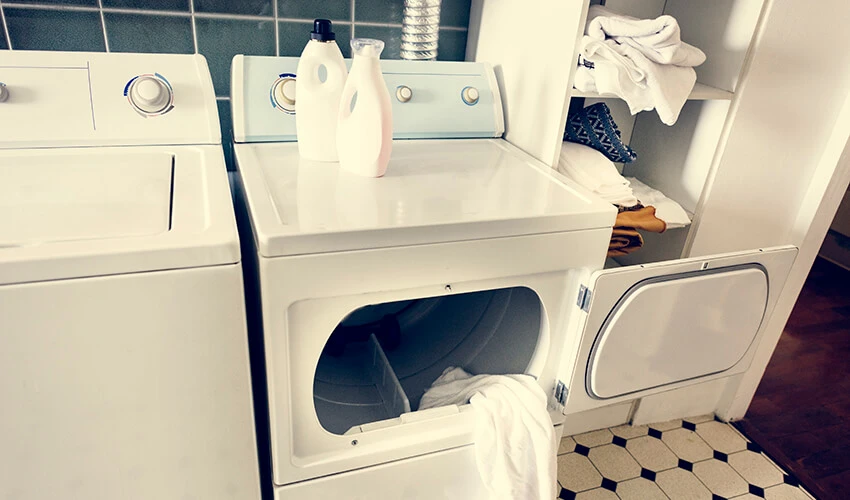15 Common Reasons Your Dryer Is Not Drying
|
Wondering “Why is my dryer not drying?” There are several reasons a dryer may malfunction, including if it’s unplugged, the breaker is tripped, the lint trap or exhaust vent is clogged, the start switch or door latch is broken, the thermal fuse is blown, or the drum is overloaded. |
Roughly 80% of American homes have a dryer, making it one of the most essential household appliances for homeowners. For busy families, having a reliable laundry room with a functional washer and dryer is essential to maintain the daily routine. So when dryers malfunction, most people find themselves asking, “Why is my dryer not drying?” and, most importantly, “How do I fix it?”
If your dryer is not drying clothes properly anymore, the problem could be due to various issues, including a power issue, a broken switch or belt, lint accumulation, or irregular dryer maintenance. Our troubleshooting experts have developed this guide to help you pinpoint why your dryer may stop working –– and help you find the fix.
For reliable assistance with a broken or malfunctioning dryer, schedule service with your local Mr. Appliance.
1. The Dryer Is Unplugged
We have to ask: Is the dryer plugged in? If the appliance has somehow become unplugged, your unit cannot turn on and dry your clothes. Check on the status of your plug before testing or looking into other potential problems. It may have become loose or dislodged, especially if you recently moved your dryer for some reason.
The Fix: Plug the unit back in.
2. You Have a Tripped Breaker
If your dryer is not drying clothes, your appliance may have tripped your breaker. Open your electrical panel and look for a breaker switch that is not aligned with the rest. Because electric dryers need two circuits to run — one to power the heating element and another to run the rest of the components — only one of your dryer’s circuit breakers may have tripped, but even if only one breaker has tripped, your dryer won’t work.
The Fix: Flip the unaligned breaker switch back over.
3. The Vent Is Restricted
A dryer can only operate efficiently if there is adequate airflow and if hot air from the appliance is vented properly. If a dryer’s vent is restricted in any way, it will not be able to dry clothes properly. Check your appliance for clogged vents, crushed or pinched vent hoses, and incorrectly installed hoses if your unit is malfunctioning.
The Fix: Clean the dryer vent, straighten out or replace hoses, and resolve incorrect installation.
4. The Lint Trap Is Blocked
Lint is the leading cause of a dryer not working. Even if you clean your lint filter after every dryer cycle, your lint trap can still become blocked. Lint that isn’t caught by your lint screen may blow into your dryer housing and vent hose, preventing the dryer from drying clothes efficiently or completely.
The Fix: Remove your dryer’s lint screen and remove any excess lint by hand. Then, use your vacuum’s narrow attachment setting to remove additional lint buildup that may be lining the walls of your dryer’s interior.
5. The Exhaust Vent Is Clogged
Clogged exhaust vents can also cause subpar drying. Clogs in these vents make it difficult for your dryer to dispel hot, moist air, which increases the time a unit needs to dry clothes. If the airflow leaving your exhaust vent is slow and cold, it's probably due for a thorough vent cleaning.
The Fix: Detach the vent hose, shake it out, and call a dryer repair professional to properly unclog your exhaust vent.
Blocked lint trap or exhaust vent? Contact your local Mr. Appliance annually for thorough and professional dryer vent cleaning services.
6. You Overloaded the Dryer Drum
Putting too many clothes in your dryer at once can stress your unit’s motor, drum, drive belt, and other components. Plus, overloading the drum can prevent sufficient airflow, trap humidity, and increase dry times. Consult your owner’s manual to learn the maximum load limit for your dryer.
The Fix: Take out part of your load and restart the cycle.
.webp)
7. The Drive Belt Needs To Be Replaced
If your dryer drum doesn’t turn during a drying cycle, your drive belt is probably broken or has become dislodged. To verify this issue, follow the instructions in your owner’s manual to open the dryer and assess the condition of the belt. If it looks damaged or won’t turn the drum, you will need to get it replaced.
The Fix: Contact your local Mr. Appliance to replace your unit’s drive belt.
8. The Heating Element Is Malfunctioning
To work efficiently, electric dryers use a heating element to warm up the air inside the dryer. After several years of use, heating elements can begin to malfunction. If your heating element no longer works or is on the fritz, your dryer will not be able to dry your clothes properly. You can likely diagnose a failing heating element on your own, but you should not attempt to replace it using DIY methods.
The Fix: Failing heating elements should be replaced by an appliance repair company like your local Mr. Appliance.
9. Your Blower Wheel Is Broken
Your blower wheel is responsible for directing airflow through a dryer. If a blower wheel is making rattling sounds or vibrating, it may need to be replaced. It’s possible to remove the blower wheel yourself, but diagnosis and repairs are best left to the professionals.
The Fix: Call a dryer service professional to replace your blower wheel.
10. Your Dryer’s Thermal Fuse Blew
Just like your car, dryers have fuses that can go bad or blow when temperatures get too hot. If these fuses blow, the unit will not turn on. While you can test thermal fuses for continuity, it's wise to let dryer repair professionals handle it. The good news is that dryer fuses are affordable and somewhat easy to replace.
The Fix: Reach out to your local Mr. Appliance and schedule a thermal fuse replacement.
11. The Motor Isn’t Working
A malfunctioning or broken dryer motor can also cause a variety of problems, which often lead to dryers not drying. Motors can stop functioning and pause the drying process, even if they still receive power. If your unit heats up but the drum or dryer is not spinning, you may need to have the motor in your appliance replaced.
The Fix: Reach out to your local Mr. Appliance to discuss motor repairs and replacements.
12. You Need a New Control Panel
A working control panel is necessary for a dryer to dry clothes properly. If you’re unable to set a timer, select your cycle, or choose a temperature, it will be difficult to use your unit. It’s possible to repair specific panel components without replacing the whole panel, but have a service professional take care of this type of repair.
The Fix: Schedule an appointment with a Mr. Appliance service professional.
13. The Door Latch Is Defective
If the door latch isn’t telling the dryer that the door is closed, the motor will not run. If this is the case, your dryer will not dry your clothes. Before repairing or replacing the door latches, read your owner’s manual to check if your child lock is engaged.
The Fix: Unplug the unit, remove the latch from under the top panel, and test it with a multimeter. If it's broken, contact a repair company.
14. The Start Switch Is Broken
Similar to the door latch, your dryer will not dry your clothes if the start switch is broken. You can test the continuity of your start switch in the same way as the door latch.
The Fix: Call a dryer repair professional to repair the unit’s start switch.
15. Your Clothes Are Too Wet
Your dryer may be in proper working order but still not drying clothes completely because the clothes are too wet. Dryers are not designed to dry clothes that are sopping wet, so you may need to adjust your washing machine’s sensors, spin cycle, or wring out your clothes before putting them in your dryer.
The Fix: Make sure you or your washing machine removes excess water from wet clothes before the dry cycle begins.
.webp)
Dryer Not Drying FAQ
Still, have questions about why your dryer isn’t drying? Our team of appliance experts provides answers to your frequently asked questions below.
How Do You Fix a Dryer That Is Not Drying?
Fixing a dryer that is not drying depends on what is causing the malfunction. You may need to clean the vents or lint trap, replace essential components like the heating element or blower wheel, or simply plug the appliance in or reset the breaker. When in doubt, leave it to a service professional.
Why Are My Clothes Still Damp After Drying?
Your clothes may still be damp after drying if your unit’s airflow is blocked. If the hot, moist air your appliance uses to dry clothes cannot escape, your clothes will reabsorb the moisture. This problem can be caused by an overloaded drum, a clogged exhaust vent, or a malfunctioning heating element.
Why Is My Dryer Running But Not Heating?
If your dryer is running but not heating, the vent may be clogged with lint. This issue traps cold, wet air inside your dryer with your clothes, which lowers the unit’s temperature and affects its drying ability. Your heating element could also be broken, limiting the unit’s ability to produce hot air.
Why Is My Dryer Not Drying Clothes in One Cycle?
Your dryer may not dry your clothes in one cycle if there is an issue with the unit’s ventilation or heating element. If either of these systems malfunctions, your unit cannot dry your clothes properly.
Fix Your Broken Dryer Fast With Mr. Appliance
If you’re sadly staring at a pile of wet clothes and asking yourself, “Why is my dryer not drying?,” it’s time to call in the appliance professionals. With years of dryer repair experience, you can count on your local Mr. Appliance to fix your broken unit so you can get back to your routine, and dry clothes.
For speedy, expert help with your busted dryer, schedule an appointment or give us a call today.
This article is intended for general guidance only and may not apply to every situation. You are responsible for determining the proper course of action for your property and your situation. Mr. Appliance is not responsible for any damages that occur as a result of any advice or guidance derived from blog content. For the most accurate guidance, contact an independently owned and operated Mr. Appliance business for a professional custom and on-site assessment.
 Click to call
Click to call



